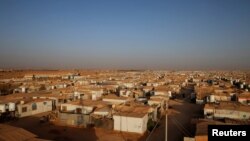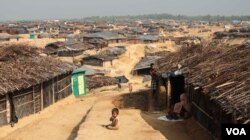Al-Zaatari is one of hundreds of camps where people forced from their homelands by armed conflicts and civil wars go, hoping that one day they will go back home.
Opened in 2012, near Jordan's border with Syria, the 5.2-square-kilometer settlement is now home to nearly 80,000 Syrian refugees.
Like many other refugee camps around the world, it ended up growing well beyond initial plans. Moving around the camp has become so challenging that the refugees wait for the water truck to pass by and then hop on it in order to get from one side of the camp to the other.
Life in the Camp
Today, there are more refugees and internally displaced people than at any point since the World War II - 65.6 million, according to the UN Commissioner for Refugees.
At the moment, says Brett Moore, Chief of the Shelter and Settlements Section at the UN refugee agency, UNHCR, it’s hard to define what a camp is.
“You might just have a collection of displaced families or a community that’s spontaneously self-settled,” he explains. “But at least those under some kind of formality - whether being designed and/or managed by UNHCR - is around 420 refugee camps globally, containing 3.2 million people.”
Living conditions vary greatly from one camp to another.
“I’ve just returned from Bangladesh and the shocking situation there for the Rohingya refugees that fled persecution in Myanmar,” Moore says. “In the largest camp, Kutapalong, there are around 700,000 people living in very dense, very poor conditions. You have other situations, for example say, in Chad, Nigeria, Cameroon, we have displaced population that have been there for 20 years or more and they are still living something akin to emergency conditions.”
Problems inside Refugee Camps
Social architecture designer Sama El Saket is one of the urban planners who have recently taken an increased interest in re-imagining refugee camps. Coming up with better designs, she says, can improve living conditions for the people there. It can also facilitate delivery of humanitarian services inside the camp and make it a safer place.
From an architectural perspective, El Saket says these camps often don’t provide refugees with a comfortable or safe living environment.
“Because the camp is laid out in a temporary manner and you end up running into problems, into security problems,” she says. “Other problems include dealing with sewage because no proper piping is introduced, no proper system of dealing with flooding. The camp fails in protecting its inhabitants from severe weather conditions, in winter and summer, because of the insufficient insulation. There are issues of sharing bathrooms between a large number of shelters.”
Working for her doctorate in urban design at Harvard University, El Saket studied seven refugee camps in Africa and Asia, including Al-Zaatari.
She found they often face common challenges, like moving refugees from rural areas to urban environment or vice versa. That takes the people from the lifestyle they’re used to and makes it harder for them to find jobs.
“Another problem in the Zaatari camp, and in other refugee camps around the world as well, is the facilities and services tend to be placed around the periphery of the camp, making it hard for refugees who are living in the center of the camp to reach these services.”
Make it Permanent
In her study, El Saket suggests changes to benefit both the refugees and the host country. Her basic recommendation is to integrate the camp. When it becomes part of the neighboring city or rural area, the refugees have better access to services and live a more normal life. And, she points out, the government saves money.
“Economically, it’s not sustainable to keep spending money on keeping up a temporary city whereas if they spend the money setting up a more permanent city, then the refugee can stay in it and if they go back to their country, then the locals in that host country can end up moving into that city and it becomes a useful infrastructure.”
Locating the camp closer to cities or villages rather than the border gives the refugees an opportunity to connect to and boost the local economy.
Improving Existing Camps
To improve an existing refugee camp, El Saket recommends evaluating the location of the services, and moving the schools, hospitals and distribution centers to places in the camp that are more accessible to the refugees. It’s also necessary to provide a means of transportation inside the camp and public spaces like plazas and theaters and mosques or other religious spaces for refugees to gather or just promote a more normal life.
“The Zaatari as my focus study, refugees in it have managed to start a market,” El Saket observes. “Through the market they’re able to sell products. They’re able to cook food and sell it and connect their services to the largest economic network in Jordan.”
UNHCR's Brett Moore says the agency is encouraging architects and other private sector experts to consider the humanitarian issues.
“I was really pleased with the work undertaken by Sama and a lot of other students looking at refugee housing issues, humanitarian issues. Even if we don’t have the ability or the budgets to put in the significant work in the beginning, at least the initial planning process helps us create the kind of settlement that if resources do become available, it can be upgraded over time.”
Re-imaging refugee camps can also raise awareness and the money needed to help refugees lead a more normal life during this challenging time.








Facebook Forum